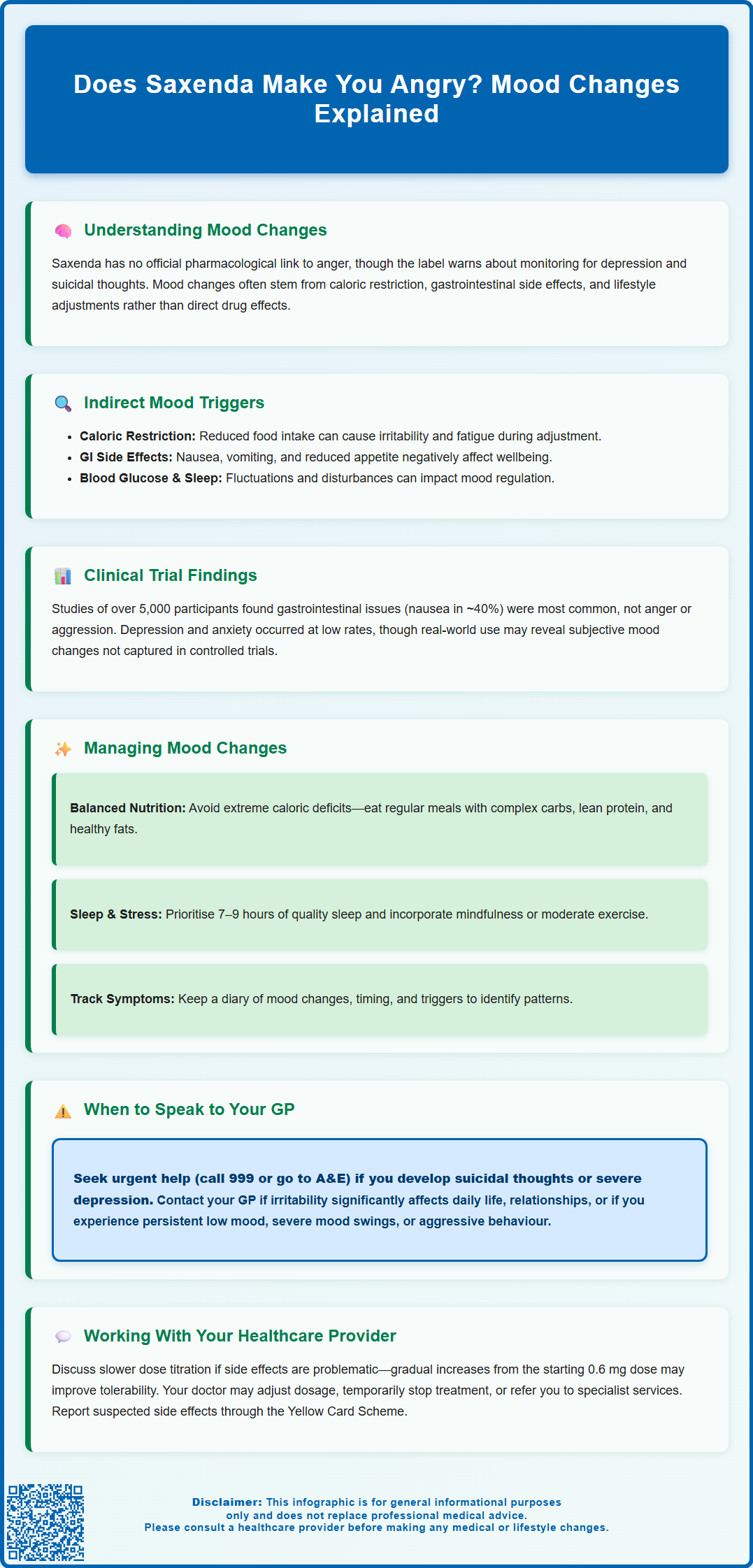Mounjaro®
Dual-agonist support that helps curb appetite, hunger, and cravings to drive substantial, sustained weight loss.
- ~22.5% average body weight loss
- Significant weight reduction
- Improves blood sugar levels
- Clinically proven weight loss

Does Saxenda make you angry? Saxenda (liraglutide 3.0 mg) is a GLP-1 receptor agonist licensed by the MHRA for weight management in adults and adolescents with obesity. Whilst some patients report irritability or mood changes during treatment, anger is not listed as a recognised adverse effect in the Summary of Product Characteristics. However, the SmPC does include warnings to monitor for depression and suicidal thoughts. Mood alterations may occur indirectly through caloric restriction, gastrointestinal side effects, or lifestyle adjustments accompanying weight-loss therapy. Understanding these potential contributing factors helps distinguish between direct drug effects and secondary influences on emotional wellbeing.
Summary: Anger is not a recognised direct adverse effect of Saxenda, though mood changes may occur indirectly through caloric restriction, gastrointestinal side effects, or lifestyle adjustments.
Saxenda (liraglutide 3.0 mg) is a glucagon-like peptide-1 (GLP-1) receptor agonist licensed by the MHRA for weight management in adults with obesity or overweight with weight-related comorbidities, and in adolescents aged 12-<18 years with obesity (>60kg). Whilst Saxenda is generally well-tolerated, some patients report experiencing mood changes, including irritability or feelings of anger during treatment. It is important to understand that there is no official, direct pharmacological link between Saxenda and anger as a recognised adverse effect in the Summary of Product Characteristics (SmPC).
However, the SmPC does include an important warning to monitor patients for depression and suicidal thoughts, with instructions to discontinue treatment if these occur. Mood alterations can occur indirectly through several mechanisms. Caloric restriction, which typically accompanies Saxenda therapy, may contribute to irritability, fatigue, and mood fluctuations—particularly during the initial adjustment period. Additionally, Saxenda commonly causes gastrointestinal side effects such as nausea, vomiting, and reduced appetite, which can affect overall wellbeing and emotional state.
Individual responses to weight-loss medications vary considerably. Some patients may experience mood changes due to alterations in eating patterns or the psychological adjustment to lifestyle modification. Blood glucose fluctuations may also influence mood stability, though hypoglycaemia is uncommon with Saxenda alone (mainly a risk when used with sulfonylureas or insulin). Sleep disturbances and fatigue—both potential indirect consequences of treatment—can further impact mood regulation. Understanding these potential contributing factors is essential for patients and healthcare professionals to distinguish between direct drug effects and secondary influences on emotional wellbeing during Saxenda therapy.
Clinical trial data from the Saxenda development programme, including the SCALE (Satiety and Clinical Adiposity – Liraglutide Evidence) studies, provide comprehensive safety information. These large-scale, randomised controlled trials involving over 5,000 participants did not identify anger or aggression as common adverse reactions. The most frequently reported side effects were gastrointestinal in nature, including nausea (affecting approximately 40% of patients), diarrhoea, constipation, vomiting, and dyspepsia.
Regarding psychiatric effects, the clinical trials documented relatively low rates of mood disorders. Depression and anxiety were reported in small percentages of participants. Importantly, the MHRA/EMC SmPC for Saxenda includes a specific warning to monitor patients for depression and suicidal thoughts, with clear instructions to discontinue treatment if these occur. This highlights the importance of ongoing mental health monitoring during treatment.
It is crucial to note that clinical trials may not capture all individual experiences, particularly subjective mood changes that patients might not formally report. Real-world use sometimes reveals effects not prominent in controlled trial settings. The European Medicines Agency (EMA) and MHRA continuously monitor safety data through pharmacovigilance systems, including the Yellow Card Scheme for reporting suspected adverse reactions.
Patients should be aware that weight loss itself can influence mood through multiple pathways, including physiological and psychological factors. Any mood changes experienced during treatment warrant discussion with healthcare professionals to determine appropriate management strategies and rule out other contributing factors such as underlying mental health conditions or concurrent medications.

If you experience irritability or mood changes whilst taking Saxenda, several practical strategies may help manage these symptoms effectively. Firstly, ensure you are following a balanced, nutritious eating plan rather than excessively restricting calories. Severe caloric deficit can contribute significantly to mood disturbances, fatigue, and irritability. Work with a registered dietitian or your healthcare team to develop a sustainable meal plan that provides adequate nutrition whilst supporting weight loss goals.
Maintaining stable blood glucose levels is particularly important. Eat regular, balanced meals containing complex carbohydrates, lean protein, and healthy fats to prevent blood sugar fluctuations that may affect mood. Stay well-hydrated, as dehydration can exacerbate feelings of irritability and fatigue. Aim for at least 1.5–2 litres of water daily, adjusting for activity level and climate.
Prioritise sleep hygiene and stress management. Aim for 7–9 hours of quality sleep nightly, as sleep deprivation significantly impacts mood regulation. Incorporate stress-reduction techniques such as mindfulness, gentle exercise, or relaxation practices into your daily routine. Regular physical activity—even moderate walking—can improve mood through endorphin release and may help manage some gastrointestinal side effects of Saxenda.
Keep a symptom diary documenting mood changes, timing, severity, and potential triggers. This information is valuable for identifying patterns and discussing concerns with your GP. If gastrointestinal side effects are contributing to mood disturbances, discuss dose titration strategies with your prescriber. According to the SmPC, Saxenda is typically started at 0.6 mg daily and gradually increased weekly; slower titration may improve tolerability. Remember that treatment should be discontinued if you have not lost at least 5% of your initial body weight after 12 weeks on the 3.0 mg daily dose, as per NICE guidance (TA664).
Prompt medical consultation is essential if you experience significant or persistent mood changes whilst taking Saxenda. If you develop suicidal thoughts or severe depression, stop taking Saxenda immediately and seek urgent medical help—call 999, go to A&E, or contact NHS urgent mental health helplines if you feel unable to keep yourself safe. For other urgent concerns, call NHS 111 for advice.
Contact your GP if you develop symptoms of depression, including persistent low mood, loss of interest in activities, changes in sleep patterns, or feelings of worthlessness. These symptoms require professional assessment regardless of their potential connection to Saxenda. The SmPC specifically advises monitoring for depression or suicidal thoughts and discontinuing treatment if these occur.
You should also seek medical advice if irritability or anger is significantly impacting your daily functioning, relationships, or quality of life. Severe mood swings, uncharacteristic aggressive behaviour, or emotional instability warrant prompt evaluation. Your GP can assess whether these symptoms might be related to Saxenda, underlying mental health conditions, or other medical factors requiring investigation.
Other concerning symptoms that require immediate medical attention include: signs of pancreatitis (severe, persistent abdominal pain radiating to the back, with or without vomiting); severe or persistent nausea and vomiting leading to dehydration; unusual fatigue, neck swelling, or voice changes; rapid or irregular heartbeat; or signs of gallbladder problems (upper abdominal pain, fever, jaundice). If you experience symptoms of hypoglycaemia—particularly if taking Saxenda alongside diabetes medications—contact your healthcare team for medication review.
Your GP may recommend adjusting your Saxenda dose, temporarily discontinuing treatment, or investigating alternative causes for mood changes. They might suggest referral to specialist services if appropriate, such as mental health support or specialist weight management clinics. NICE guidance emphasises the importance of ongoing monitoring and support for patients receiving pharmacological weight management interventions. You can report any suspected side effects to the MHRA through the Yellow Card Scheme (yellowcard.mhra.gov.uk).
No, anger is not listed as a recognised adverse effect in the Saxenda Summary of Product Characteristics. However, the SmPC does include warnings to monitor for depression and suicidal thoughts, and mood changes may occur indirectly through factors such as caloric restriction or gastrointestinal side effects.
Contact your GP if you experience significant mood changes, irritability, or depression whilst taking Saxenda. If you develop suicidal thoughts or severe depression, stop taking Saxenda immediately and seek urgent medical help by calling 999 or attending A&E.
Maintain a balanced, nutritious eating plan rather than excessively restricting calories, ensure stable blood glucose levels through regular meals, stay well-hydrated, prioritise 7–9 hours of sleep nightly, and incorporate stress-reduction techniques such as mindfulness or gentle exercise into your daily routine.
The health-related content published on this site is based on credible scientific sources and is periodically reviewed to ensure accuracy and relevance. Although we aim to reflect the most current medical knowledge, the material is meant for general education and awareness only.
The information on this site is not a substitute for professional medical advice. For any health concerns, please speak with a qualified medical professional. By using this information, you acknowledge responsibility for any decisions made and understand we are not liable for any consequences that may result.
Lorem ipsum dolor sit amet, consectetur adipiscing elit, sed do eiusmod tempor incididunt ut labore et dolore magna aliqua. Ut enim ad minim veniam, quis nostrud exercitation ullamco laboris nisi ut aliquip ex ea commodo consequat. Duis aute irure dolor in reprehenderit in voluptate velit esse cillum dolore eu fugiat nulla pariatur.
Block quote
Ordered list
Unordered list
Bold text
Emphasis
Superscript
Subscript